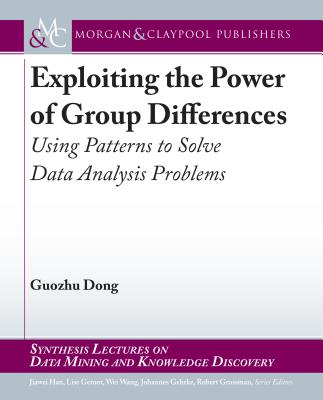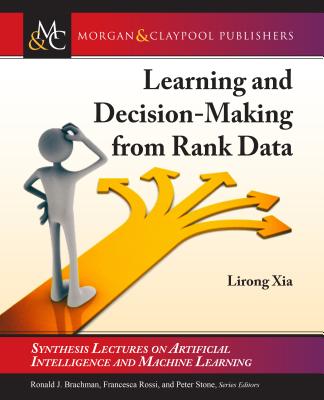Probabilistic Approaches to Recommendations (Paperback)
暫譯: 推薦的機率方法 (平裝本)
Nicola Barbieri, Giuseppe Manco, Ettore Ritacco
- 出版商: Morgan & Claypool
- 出版日期: 2014-05-01
- 售價: $1,680
- 貴賓價: 9.5 折 $1,596
- 語言: 英文
- 頁數: 198
- 裝訂: Paperback
- ISBN: 1627052577
- ISBN-13: 9781627052573
-
相關分類:
推薦系統
海外代購書籍(需單獨結帳)
買這商品的人也買了...
-
 Linux Device Driver Programming 驅動程式設計
Linux Device Driver Programming 驅動程式設計$690$538 -
 鳥哥的 Linux 私房菜-基礎學習篇, 3/e
鳥哥的 Linux 私房菜-基礎學習篇, 3/e$820$648 -
 Processing 入門-互動式圖形實作介紹 (Getting Started with Processing)
Processing 入門-互動式圖形實作介紹 (Getting Started with Processing)$400$316 -
 MATLAB 程式設計-進階篇, 2/e
MATLAB 程式設計-進階篇, 2/e$560$442 -
 Arduino DUE R3 ARM 32位(相容板)附 micro USB線 | Atmel SAM3X8E
Arduino DUE R3 ARM 32位(相容板)附 micro USB線 | Atmel SAM3X8E$1,360$1,292 -
 $354Node.js 入門經典 (Sams Teach Yourself Node.js in 24 Hours)
$354Node.js 入門經典 (Sams Teach Yourself Node.js in 24 Hours) -
 3D 虛擬實境設計:FancyDesigner 的實務應用
3D 虛擬實境設計:FancyDesigner 的實務應用$380$300 -
 Python 錦囊妙計, 3/e (Python Cookbook, 3/e)
Python 錦囊妙計, 3/e (Python Cookbook, 3/e)$880$695 -
 改變世界的九大演算法 : 讓今日電腦無所不能的最強概念 (Nine Algorithms That Changed the Future: The Ingenious Ideas That Drive Today’s Computers)
改變世界的九大演算法 : 讓今日電腦無所不能的最強概念 (Nine Algorithms That Changed the Future: The Ingenious Ideas That Drive Today’s Computers)$360$284 -
 網站滲透測試實務入門
網站滲透測試實務入門$380$300 -
 養成 iOS 8 App 程式設計實力的 25 堂課-最新 Swift 開發教學(A Practical Guide to Building Your First App from Scratch: Beginning iOS 8 Programming with Swift)
養成 iOS 8 App 程式設計實力的 25 堂課-最新 Swift 開發教學(A Practical Guide to Building Your First App from Scratch: Beginning iOS 8 Programming with Swift)$580$452 -
 Swift初學特訓班--iOS App 開發快速養成與實戰(附近3小時新手入門與關鍵影音教學/全書範例程式)
Swift初學特訓班--iOS App 開發快速養成與實戰(附近3小時新手入門與關鍵影音教學/全書範例程式)$420$332 -
 深入理解 Android 核心設計思想-應用實測篇
深入理解 Android 核心設計思想-應用實測篇$380$296 -
 Raspberry Pi 超炫專案與完全實戰 (深入 Raspberry Pi 的全面開發經典) (附101段教學與執行影片/範例程式)
Raspberry Pi 超炫專案與完全實戰 (深入 Raspberry Pi 的全面開發經典) (附101段教學與執行影片/範例程式)$520$411 -
 Python 程式設計入門 (適用於 2.x 與 3.x 版)
Python 程式設計入門 (適用於 2.x 與 3.x 版)$620$484 -
 Kali Linux 滲透測試工具
Kali Linux 滲透測試工具$490$387 -
 LinkIt ONE 物聯網實作入門
LinkIt ONE 物聯網實作入門$280$252 -
 Docker 入門與實戰
Docker 入門與實戰$450$356 -
 你不能錯過的 CSS 指南:實用 X 必用 X 拿來即用的 400 段程式碼 + 151 個範例
你不能錯過的 CSS 指南:實用 X 必用 X 拿來即用的 400 段程式碼 + 151 個範例$490$387 -
 達標!Windows 10
達標!Windows 10$520$442 -
 R 軟體資料分析基礎與應用 (R for Everyone: Advanced Analytics and Graphics)
R 軟體資料分析基礎與應用 (R for Everyone: Advanced Analytics and Graphics)$650$514 -
 PHP、MySQL 與 JavaScript 學習手冊, 4/e (Learning PHP, MySQL & JavaScript: With jQuery, CSS & HTML5, 4/e)
PHP、MySQL 與 JavaScript 學習手冊, 4/e (Learning PHP, MySQL & JavaScript: With jQuery, CSS & HTML5, 4/e)$980$774 -
 OpenCV 程式設計參考手冊
OpenCV 程式設計參考手冊$620$490 -
 接案我最行:jQuery 經典範例必殺技
接案我最行:jQuery 經典範例必殺技$480$379 -
 完整學會 Git, GitHub, Git Server 的24堂課
完整學會 Git, GitHub, Git Server 的24堂課$360$284
商品描述
The importance of accurate recommender systems has been widely recognized by academia and industry, and recommendation is rapidly becoming one of the most successful applications of data mining and machine learning. Understanding and predicting the choices and preferences of users is a challenging task: real-world scenarios involve users behaving in complex situations, where prior beliefs, specific tendencies, and reciprocal influences jointly contribute to determining the preferences of users toward huge amounts of information, services, and products. Probabilistic modeling represents a robust formal mathematical framework to model these assumptions and study their effects in the recommendation process.
This book starts with a brief summary of the recommendation problem and its challenges and a review of some widely used techniques Next, we introduce and discuss probabilistic approaches for modeling preference data. We focus our attention on methods based on latent factors, such as mixture models, probabilistic matrix factorization, and topic models, for explicit and implicit preference data. These methods represent a significant advance in the research and technology of recommendation. The resulting models allow us to identify complex patterns in preference data, which can be exploited to predict future purchases effectively.
The extreme sparsity of preference data poses serious challenges to the modeling of user preferences, especially in the cases where few observations are available. Bayesian inference techniques elegantly address the need for regularization, and their integration with latent factor modeling helps to boost the performances of the basic techniques.
We summarize the strengths and weakness of several approaches by considering two different but related evaluation perspectives, namely, rating prediction and recommendation accuracy. Furthermore, we describe how probabilistic methods based on latent factors enable the exploitation of preference patterns in novel applications beyond rating prediction or recommendation accuracy.
We finally discuss the application of probabilistic techniques in two additional scenarios, characterized by the availability of side information besides preference data. In summary, the book categorizes the myriad probabilistic approaches to recommendations and provides guidelines for their adoption in real-world situations.
Table of Contents: Preface / The Recommendation Process / Probabilistic Models for Collaborative Filtering / Bayesian Modeling / Exploiting Probabilistic Models / Contextual Information / Social Recommender Systems / Conclusions / Bibliography / Authors' Biographies
商品描述(中文翻譯)
推薦系統的準確性在學術界和業界都受到廣泛重視,推薦正迅速成為數據挖掘和機器學習最成功的應用之一。理解和預測用戶的選擇和偏好是一項具有挑戰性的任務:現實世界的情境涉及用戶在複雜情況下的行為,其中先前的信念、特定的傾向和相互影響共同決定了用戶對大量信息、服務和產品的偏好。概率建模代表了一種穩健的正式數學框架,用於建模這些假設並研究其在推薦過程中的影響。
本書首先簡要總結了推薦問題及其挑戰,並回顧了一些廣泛使用的技術。接下來,我們介紹並討論了用於建模偏好數據的概率方法。我們專注於基於潛在因子的技術,例如混合模型、概率矩陣分解和主題模型,這些方法適用於顯式和隱式偏好數據。這些方法在推薦的研究和技術上代表了顯著的進展。所得到的模型使我們能夠識別偏好數據中的複雜模式,這些模式可以有效地用於預測未來的購買行為。
偏好數據的極度稀疏性對用戶偏好的建模提出了嚴峻的挑戰,特別是在可用觀察數量較少的情況下。貝葉斯推斷技術優雅地解決了正則化的需求,並且與潛在因子建模的整合有助於提升基本技術的性能。
我們通過考慮兩個不同但相關的評估視角,即評分預測和推薦準確性,總結了幾種方法的優缺點。此外,我們描述了基於潛在因子的概率方法如何使得在評分預測或推薦準確性之外的新應用中利用偏好模式。
最後,我們討論了概率技術在兩個額外場景中的應用,這些場景的特點是除了偏好數據外還有側面信息的可用性。總之,本書對各種概率方法進行了分類,並提供了在現實情況中採用這些方法的指導。
目錄:前言 / 推薦過程 / 協同過濾的概率模型 / 貝葉斯建模 / 利用概率模型 / 上下文信息 / 社交推薦系統 / 結論 / 參考文獻 / 作者簡介













